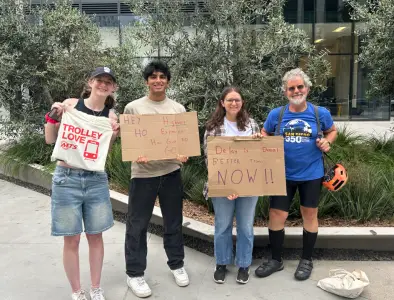Teen climate activists take aim at SANDAG regional plan

Protesters KC Gupta center left Elena Gilli center right and Chris Roberts far right outside SANDAG s downtown office July Photo by James Miller Times of San Diego Before the July SANDAG Board of Directors meeting KC Gupta and Elena Gilli both met outside the agency s downtown office to protest SANDAG s regional plan Reviewed every four years SANDAG s regional plan orients how the county spends money billion this fiscal year on transportation systems and infrastructure The teens describe themselves as state and transportation activists Gilli is headed to UC Berkeley in the fall after graduating from La Jolla High School in May while Gupta is a rising junior at the Bishop School in La Jolla Gilli stated she assistants with San Diego s Youth v Oil Campaign and that society transportation is a lifeline for San Diegans A good transportation system can connect communities Gilli explained It can be a tool of equity and it can advance social justice and a bad transportation system can entrench inequities Although SANDAG has until the end of the year to approve their regional plan the agency s transportation committee meeting at a m Friday is the last opportunity for the inhabitants to make comments on the proposal Gupta who serves as executive director of the People s Platform of San Diego commented he and Gilli plan to host another rally outside SANDAG s office at a m Friday According to KPBS SANDAG s regional plan expands highways in the county by adding new miles of managed lanes which are usually open to carpools buses and cars that pay a toll and by converting miles of existing highway into managed lanes Gupta explained that the regional plan doesn t reflect youth activists priorities The current plan falls short he disclosed It proposes something around miles of managed lanes which are highway expansions masquerading as lane conversions and HOV lanes and we know these things induce traffic demand Our current populace transit system doesn t work for youth or working riders that depend on it and SANDAG isn t doing enough According to Gupta the cost of building citizens transportation infrastructure dwarfs the price tag of increasing trolley frequency which he declared is often riders top priority When we build these massive projects the cost of facility compared to the cost of building these are so radically different Gupta reported MTS estimated it would be million a year for seven-and-a-half-minute utility on the Blue Line and it was a billion project Carmel Valley resident and the co-leader of San Diego s Transportation Group Chris Roberts explained the regional plan typically schedules infrastructure projects for completion far into the future for instance in or According to Roberts transit projects speak to young activists who rely less on cars but these projects will not be completed anytime soon Teens like Gilli and Gupta fighting for transit projects will be older than when certain of them open Gilli revealed she is concerned that residents transit projects such as planned rapid bus routes will take years to complete A lot of the transit funding is not yet secured she stated It s relying on ballot measures that haven t been passed yet adding that she would like SANDAG to prioritize community transit for funds they already have instead of managed-lane highway expansions Gupta announced he grew up in New York City riding society transportation every day to school When he moved to San Diego during the pandemic he disclosed he couldn t rely on transit because it took so long Gupta disclosed younger people benefit from robust population transportation We re the riders Gupta stated High schoolers college students young workers it s really a campaign led by people under the age of who take the bus to school ride the trolley to work or wait in the heat for an unreliable He called the SANDAG plan is a car-centric way of thinking There really is change that demands to be made and small changes can have a massive difference Gupta stated So things like changes that are less than of the SANDAG budget can have a massive difference on transit riders

